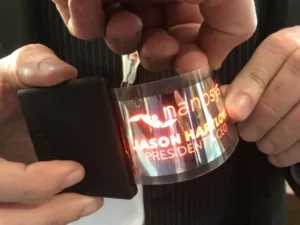When I was a kid and heard the famous story of the Tortoise and the Hare, I was struck by the numerous morals woven into the tale. Was it the arrogance of the Hare that lost it the race? Or was it the persistence of the Tortoise that allowed it to be victorious? Perhaps both. Either way, I can’t help but feel like there is an analogy to be made to emissive display technology that was presented at the QD Forum 2019:

- Tortoise = Electroluminescent (EL)-QLED technology
- Hare = Micro LED, other “new” tech
Perhaps it’s because I’ve been involved with QDs for a while now, but it seems like forever that we have been claiming that EL-QLED technology will be “the” emissive display technology of the future. It’s been well over a decade that we have been saying this, but still it seems so far away. Meanwhile, microLEDs have skyrocketed to stardom in the past few years and garnished significant investment and press which makes it look as though microLEDs could make it to the finish line first. The uptick in patent activity in the past few years is striking (credit: Eric Virey, Yole)

In March, the Quantum Dot and Phosphor community came together at their yearly forum to show off the latest and greatest and discuss what’s coming next. Industry giants, consultants (including yours truly) and famed academics shared their insight on how QD technology is being and will be commercialized in many different fields, but, of course, a lot of us were there for the display-centric discussion.
EL-QLED was a common theme amongst many of the top players on the display side. The conference was kicked off by Nanosys CEO, Jason Hartlove, who donned a unique name card – a flexible EL-QLED display using their InP QDs. Pretty slick marketing that points to the fact that, in principle, QDs can do anything OLED can do.
 Nanosys had this label (Photo credit: Palomaki Consulting) – click for higher resolution
Nanosys had this label (Photo credit: Palomaki Consulting) – click for higher resolution
While Nanosys did not share much information about the status of their devices, others were more forthcoming about current performance.
Nanophotonica shared performance metrics of their devices, which were similar to previous years. They claim mpressive efficiencies for red and green (>20%) and blue has a respectable 15% based on some improvements to the other layers in the stack, in particular doped ZnO. I’ve said it before, and I’ll say it again, but in the reliability department Red=good, Green=ok, Blue=bad.
TCL provided a very detailed analysis of some recent work they have done to improve the reliability of their EL-QLEDs. The result was an impressive T95 (time to 95% luminance) of >4000 hours for red, and >1500 hours for green. In the past, most companies were reporting T50 lifetimes for green, so just the fact that they can report T95 is impressive. As for blue (do I have to tell you?)… T95 is in the 10s of hours. But at least they’re moving forward, even if it is at tortoise speeds.
It’s worth noting that both TCL and Nanophotonica devices were made using Cd-containing QDs. Below is a summary of TCLs performance presented at the QD Forum.
 TCL QLED performance (Photo credit: Palomaki Consulting)
TCL QLED performance (Photo credit: Palomaki Consulting)
Samsung maintains its focus on non-Cd QDs with some interesting information shared about their blue QDs. Instead of using InP-based QDs for blue (which have a broad peak and poor efficiency) they focused on a ZnTeSe core with a ZnSeS shell. The result is a QD with narrow peak width of 20nm and quantum yield > 80%. No word as to how they perform in EL mode, but I think we can all guess.
I love projections just as much as the next person, so I asked Bob O’Brien from Display Supply Chain Consultants about EL-QLED, and he admitted that it was not included in their 5-year projection. For now, they are including QD film, QD on glass, and QD color filters with OLED backlight in their model for quantum dot-containing display technologies. Another important takeaway from Bob’s talk was that the major display manufactures are expecting microLED to become mainstream. This hypothesis is supported by the fact that no one is planning for new LCD fabs beyond gen 10.5, and if there were not a disruption like microLED or EL-QLED coming along, then we would see gen >10.5 in the works, but it’s not happening. The disruption is already occurring by having an impact on how LCD fabs are planning for their future.
I’m comfortable with EL-QLED being the tortoise. It gives the technology the opportunity to surprise the world. Perhaps the persistent incremental increase in performance will allow it to reach commercial viability before we know it. Watch out hare, we’re coming for you. (PP)
Peter Palomaki is the owner and chief scientist at Palomaki Consulting, a firm specializing in helping companies solve big problems at the nanoscale. His utilizes his expertise in quantum dots and materials chemistry to solve challenging problems with clients large and small.
www.linkedin.com/in/ppalomaki
@nanopalomaki
Analyst Comment
Pete is running a webinar on Tuesday April 23 – you can register here.
You can also watch Jason Hartlove’s talk on Youtube. Nanosys also provided us with his ![]() slides from the event. (BR)
slides from the event. (BR)

